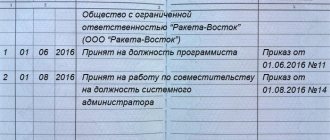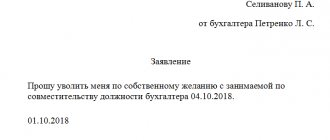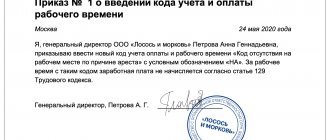The Labor Code of the Russian Federation allows for the possibility of employment for additional work. An employee can perform additional duties simultaneously with his main job or in his free time. Depending on this, the employer and the employee formalize a part-time job (internal or external) or combination.
This article will discuss internal part-time work, its differences from part-time work, and the correct registration of an employee for additional work in accordance with current legislation.
Part-time work: concept and types
Quite often, an enterprise has employees registered as part-time workers.
Part-time work means that an employee works in one organization in the main position, and at the same/another enterprise performs some regular type of activity in his free time (Article 282 of the Labor Code of the Russian Federation). The key words in this case are “free time” and “regularity”.
Part-time work can be:
- external (main and additional work is performed in different organizations);
- internal (additional work is performed in the same organization as the main one).
Registration of a full-time employee as a part-time employee is often more profitable for the employer than searching for and hiring an applicant (despite the fact that he may refuse this job even after completing his training). Workers also benefit from the institution of part-time work, as it allows them to receive additional income.
The specificity of part-time employment is that the conditions of such work are made dependent on the applicant’s main job for the position. That is, if the applicant does not have a main job, then he cannot be hired for a part-time job.
In Art. 60.1, 66, 68, 282 - 288 of the Labor Code of the Russian Federation do not provide for any restrictions related to the number of registrations for a part-time worker. That is, you can apply for a part-time job as many times as necessary (depending only on desire and strength).
Vacation for part-time workers
A part-time worker has the right to receive leave from an “additional” employer simultaneously with leave for his main job (Part 1 of Article 286 of the Labor Code of the Russian Federation). Moreover, in this case, leave from a part-time job must be provided “in advance,” even if the length of service is less than six months. Obviously, in order to receive the benefit, the employee must confirm that he has taken leave for his main job. This can be done either with a certificate from the “main” employer, or with a copy of the leave order.
Please note that the practical application of these provisions in relation to external part-time workers may cause difficulties. The fact is that the Labor Code obliges the employer to warn employees about the upcoming vacation against signature at least two weeks in advance (Part 3 of Article 123 of the Labor Code of the Russian Federation). And no exceptions are made for external part-time workers. But at the same time, data on the rest time of part-time workers is usually not included in the vacation schedule. The reason is that this can only be done after the schedule for the main place of work has been approved.
In this regard, we recommend including in the employment contract with a part-time worker a provision stating that he is obliged to notify about the start date of vacation at his main place of work at least two weeks in advance. This will avoid a fine for late notification of a part-time worker about leave (if he fails to fulfill this obligation). In this case, the notification must be served immediately after receipt of the application for leave, even if there are less than two weeks left before it begins (Part 2 of Article 2.1 of the Administrative Code; see decision of the Ivanovo Regional Court dated March 30, 2017 No. 21-82/2017).
In addition, difficulties may arise if the duration of vacation for the main job is longer than for a part-time job. In this case, a part-time worker (both external and internal) has the right to “equalize” the rest time by taking leave without pay. By virtue of the direct indication of Article 286 of the Labor Code of the Russian Federation, an “additional” employer cannot refuse such an application.
At the same time, the employer cannot “force” send a part-time worker on unpaid leave. Therefore, in the absence of such a statement, the employee must begin additional work immediately after the end of the “part-time” vacation. Even if he still continues to rest due to his main job.
Internal part-time and combination: what is the difference
Very often the concepts of “internal part-time work” and “combination” are confused, considering them synonymous. In fact, these are two different options for designing additional work.
Article 60 of the Labor Code of the Russian Federation prohibits requiring an employee to perform duties not stipulated by his employment contract. Therefore, if an employer requires an employee to expand the range of his duties, perform work in a different profession, or replace a temporarily absent employee, then the legislation provides two options for registering additional work for an already registered employee: part-time or part-time work.
Part-time work represents the full performance of duties by an employee with the mandatory conclusion of an employment contract (Article 60.1 of the Labor Code of the Russian Federation). In this case, additional work is performed regardless of the main duties in the time free from the main job. Part-time work is regulated by Chapter 44 of the Labor Code of the Russian Federation. The procedure for part-time work for teachers and doctors has certain features; it is determined by regulations of the Government of the Russian Federation for each category of these persons.
Part-time employment is issued for vacant positions. After registration, the part-time worker is assigned an independent personnel number. Keeping records of the working hours of a part-time employee and the main position is carried out separately.
If the employer finds another employee for a part-time position, for whom this work will be the main one, then he can fire the part-time employee. This right of the employer is provided for in Art. 288 Labor Code of the Russian Federation. In this case, the part-time partner must be notified 2 weeks before the date of termination of the contract.
Internal combination is the performance by an employee of an organization of additional duties without interruption from his main job. In this case, new work is performed for the same (increase in the volume of work) or related (expansion of responsibilities) position within the framework of one employment contract. For combination, it is not necessary to have vacant positions; it can also be registered for an occupied position (for example, during the absence of the main employee). The possibility of combination must be provided for in a collective agreement or other local act of the organization. on the time sheet .
For greater clarity, let us combine the distinctive features of internal part-time and combination in the table.
What is combination
Article 60.2 of the Labor Code of the Russian Federation allows, with the written consent of the employee, to entrust him with additional duties that were not initially provided for in the employment contract. If such work is carried out along with the main work during the working day without increasing its duration, then this is called combination.
There are different forms of combination. So, it is possible to combine professions or positions. For example, a driver performs the duties of a freight forwarder. Or a deputy - the responsibilities of a manager.
Attention
Professions (positions) filled in a combination manner must be provided for in the staffing table.
Without this, problems may arise with the tax accounting of additional payments for performing additional work, as well as with the payment of state benefits due to the employee (see, for example, decisions of the Fifteenth Arbitration Court of Appeal dated February 15, 2012 No. 15AP-15046/2011 and FAS Volga District dated April 12. 11 in case No. A12-11725/2010). Create a staffing table using a ready-made template Try for free
Another combination option is expanding the service area or increasing the scope of work. For example, a sales manager takes over the work with clients of a colleague during his vacation, or an accountant “closes” an additional area during the illness of his colleague.
In any case, an additional payment is due for the combination (Article of the Labor Code of the Russian Federation). The employer indicates its amount in the proposal to perform additional work. The employee has the right to accept or reject this offer.
To refuse a combination, you need to notify the other party to the contract three working days in advance. Both the employer and the employee have this right (Article 60.2 of the Labor Code of the Russian Federation).
Internal part-time work: limitations and features
There are categories of workers for whom part-time work is prohibited by labor legislation. In accordance with Art. 282, 329, 276 of the Labor Code of the Russian Federation it is unacceptable to hire as part-time workers:
- minors;
- persons who work in their main job with harmful (dangerous) working conditions, if part-time work will be carried out in similar conditions;
- employees of state and municipal institutions;
- persons whose main work is related to driving or moving vehicles, if the planned part-time work is similar;
- military personnel (except for such industries as pedagogy, science and creativity, provided that such part-time work will not interfere with the performance of military duties);
- security guards in relation to public service and paid work in public associations;
- judges, lawyers, prosecutors (except for such industries as pedagogy, science and creativity);
- heads of organizations without consent to part-time work from the general meeting of the organization’s participants (board of directors), from the main place of work.
Internal part-time work has a number of features:
- Internal part-time work is in fact additional work performed in free time from the main job in the same organization.
- In case of internal part-time work, a separate employment contract must be concluded between the employee and the employer (Article 282 of the Labor Code of the Russian Federation).
- Since the internal part-time worker has already been registered with this employer, he does not need to provide any documents to conclude an employment contract. An exception is a document confirming the competence of a part-time worker if the new job requires special qualifications.
- It is necessary to indicate in the employment contract and in the hiring order that it is an internal part-time worker who is being hired.
- Full-time internal part-time work is not possible.
- In case of internal part-time work, a separate time sheet is kept for the employee. This allows you to control the number of hours worked and prevent overtime (Article 91 of the Labor Code of the Russian Federation).
- An entry about part-time work in the work book is made at the request of the employee (Article 66 of the Labor Code of the Russian Federation).
How is the combination arranged?
The employer must first make a formal written offer to the employee to perform additional work. It indicates exactly what work will need to be done, for how long and for what additional payment.
If the employee does not mind, then he puts a mark of consent on this document and certifies it with his signature indicating the date. Based on this document, an order or instruction is issued (for example, on combining professions or positions; on expanding service areas; on increasing the volume of work). This document reproduces all the same conditions that were stated in the employer’s written offer. The order also provides a link to the specified proposal, in which the employee marked his consent to the combination. The employee must be familiarized with this order and signed.
Information about the combination is not entered into the employee’s work book and personal card. An additional employment contract is not concluded.
Remuneration for internal part-time workers
Remuneration for internal part-time workers is carried out in accordance with Art. 25 Labor Code of the Russian Federation.
Types of remuneration for internal part-time workers:
- time-based (proportional to working hours);
- piecework (depending on output);
- by agreement of the parties (the conditions are specified in the employment contract).
The guaranteed payment for a part-time worker is fixed in the employment contract, taking into account the wage system at the enterprise (Article 135 of the Labor Code of the Russian Federation). A part-time employee has the right to receive allowances, bonuses and other compensation and incentive payments on a general basis, if such additional payments are provided for by regulations, collective agreements and contracts, and internal regulations of the employer.
Transfers, permanent and temporary
These types of personnel changes are another option to effectively use the professional potential of employees. Operations have much in common, but there are nuances that force the manager to be extremely careful in his choice. To avoid mistakes, the employer must rely on Art. 72.1 Labor Code of the Russian Federation. Resolution of the Plenum of the Supreme Court of the Russian Federation dated March 17, 2004 No. 2 will also be useful.
The main difference between the concepts under consideration is whether the employee’s job function or place of work changes. If so, this should be considered a transfer, and the employer must obtain the employee's consent to process it.
Permanent transfers include:
- transfer of an employee to another job with the same employer in the same area;
- change of structural unit in the case when what is specified in the TD changes to another in the same area;
- relocation of an employee together with an organization/branch to another location.
A special type is the transfer of an employee to another employer. In practice, it is often called “dismissal of an employee by transfer”.
There is a temporary transfer option for up to 1 year. In this case, the employee’s consent is also required. An employer can transfer his employee to another job without written consent for a period of no more than one month only in exceptional cases (Article 72.2 of the Labor Code of the Russian Federation):
- to prevent a natural or man-made disaster, industrial accident, industrial accident - in any exceptional cases that endanger human life and health;
- during downtime, if necessary, to prevent damage or destruction of property, to replace a temporarily absent employee, if this is dictated by emergency circumstances.
To formalize the transfer, enter into an additional agreement with the employee based on his application or a memo from his immediate supervisor with his, the employee’s, consent. The exception is the case of dismissal by transfer, when the new employer draws up its employment contract with the accepted employee. After the parties have signed the additional agreement/employment contract, an order is issued and information about the permanent transfer is entered into the work book.
Internal part-time work: how many bets are possible under the Labor Code of the Russian Federation
The tariff rate is included in the tariff system for differentiating wages of workers of certain categories (Article 143 of the Labor Code of the Russian Federation).
In practice, normal working hours are 8 hours per day (40 hours per week). This is the length of the working day that corresponds to the full tariff rate. At the same time, Part 1 of Art. 284 of the Labor Code of the Russian Federation establishes a limit on working hours for part-time work - no more than 4 hours a day. Consequently, in proportion, a part-time worker can be hired for no more than 0.5 of the tariff rate.
However, Part 1 of Art. 284 of the Labor Code of the Russian Federation allows that a part-time worker can work full time (shift) if he is free from performing job duties at his main place of work.
So, under standard working conditions, an internal part-time worker can only work at 1.5 times the wage rate (the full rate at the main place of work is 0.5 times the internal part-time rate).
How to fire a part-time worker
A part-time worker (both external and internal) can be dismissed on the same grounds as the main employee: at his own request, by agreement of the parties, upon expiration of the contract, due to various misconduct, etc. For more information, see “How to fire an employee in 2021: step-by-step instructions for the employer.”
Prepare a termination agreement for free using a ready-made template
In addition, Article 288 of the Labor Code of the Russian Federation establishes an additional basis for parting with a part-time employee - hiring a main employee in his place. The employee must be notified of this in writing at least two weeks in advance. Also see: “The Ministry of Labor clarified whether it is possible to fire a part-time worker if a “main” employee has been found for the “joint” position.”
REFERENCE
Is it necessary to fire a part-time worker if his employment contract for his main job is terminated?
No no need. Although it is implied that a part-time worker must have a “main” job (Article 282 of the Labor Code of the Russian Federation), the Labor Code does not provide for such grounds for dismissal of a part-time worker as termination of employment at the main place of work. In terms of documenting the dismissal, the main difference is the absence of the obligation to make an entry in the paper work book of an external part-time worker. However, this does not exclude the need to submit a SZV-TD. This form must be submitted upon dismissal of both external and internal part-time employees.
IMPORTANT
Upon dismissal, a part-time employee must be given the same documents as any other employee (for the list, see the article “Documents upon dismissal of an employee”).
The exception is a paper work book. But information on the STD-R form must be provided. But only if the employee has switched to an electronic version of the work book (see “How to fill out the STD-R form and issue it to the employee”). If the employee has saved a paper version of the document, then he can obtain information about his work activity (in the STD-PFR form) from the Pension Fund, the MFC or through the state portal). Like regular employees, resigning part-time workers (external and internal) have the right to monetary compensation for days of unused vacation. When calculating it, you must remember that only part-time income is taken into account. This is especially true for internal part-time workers. Their employer has complete information about their income and may mistakenly inflate compensation. Note that in this case it will not be possible to recover it back without the employee’s consent (Article 137 of the Labor Code of the Russian Federation).
As you can see, part-time work has many subtleties: a special procedure for hiring and firing, its own rules for granting vacations, restrictions on working hours. Knowledge and thorough implementation of all requirements will allow you to avoid both claims from inspectors and conflicts with part-time workers themselves.
Documents for internal part-time work and part-time work from the employee
When applying for an internal part-time job, the employee must first write an application. In principle, an application for a part-time job is not very different from the application that an employee writes when applying for a main job.
In case of internal part-time and part-time work, you do not need to present your passport and education documents to the employer again, since they have already been provided to the HR department during employment for the main job.
The only exception in this case is the employment of the main employee for additional work, which requires the presence of other qualifications.
Part-time employment contract
An employment contract with an internal part-time worker is not very different from a standard employment contract. According to the standard, it is made in two copies (one for each side). The main difference is that it must contain the mark “on a part-time basis.”
Also, the contract must separately specify the number of working hours, since in accordance with labor legislation, the number of working hours of a part-time worker must be half less than the working hours of the main job for a calendar month.
In addition, according to the standard, an employment contract must include the following employment conditions:
- rights and obligations of the employee and employer;
- wages and social guarantees;
- working time and rest time;
- liability of the parties to the contract;
- amendment and termination of the employment contract;
- contract time.
An employment contract with an internal part-time employee can be fixed-term or indefinite, depending on the agreements between the parties and the specifics of the work performed.
Can internal part-time work become the main job?
Labor legislation does not provide for a ban on the transition of internal part-time work to the category of the main job. There are two ways to make such a transition:
- The part-time worker is dismissed from the main place of work by order, and an additional agreement on the transition to the main job is drawn up to the part-time employment contract.
- The employee is completely dismissed from both positions and then rehired with a new employment contract.
We automate the work
The movement of personnel in the Kontur-Personnel program is formalized through various forms of orders. It’s not difficult to compose them; the algorithm for filling out and checking is general, but there are nuances that are worth paying attention to.
General procedure. To arrange a part-time job, combination or transfer:
- Select the menu item Current work / Orders.
- In the Register of Orders in the Personnel category, select the desired order - for example, On Transfer.
- Indicate the date of the order. By default, the system will display the current date, but it may not coincide with the employee’s start date.
- Enter data in accordance with the specifics of the order, fill in the fields manually or select entries from the directory.
- After this, you can check the printed order form. The Kontur-Personnel program contains all the necessary forms, including forms of an effective contract and additional agreements.
- Approve the order, after which the system will post the data into employee cards.
For part-time workers. Part-time work is a new employment relationship with an employee. Therefore, a new employment contract must be concluded. In the Kontur-Personnel program, both internal and external part-time jobs are formalized through an admission order. And in the Type of work field you must indicate “part-time”.
You can find the order in the register of orders in the folder For personnel / About admission.
About combination and substitution. There is no need to conclude a separate employment contract when combining positions or professions.
The workload in excess of the main work is formalized by an additional agreement of the parties. To formalize the performance by an employee of the duties of a temporarily absent employee in the event of vacation or sick leave, you must pay attention to the following fields in the order: TN substitute. employee, full name of deputy employee and the position of the person being replaced. You can find the order in the register of orders in the folder For personnel / On permission to combine.
Translations. Transfers, as mentioned above, are divided into permanent and temporary. When completing them, you must pay attention to the following fields in the order: Nature of work and Type of transfer. These fields are required.
You can find the order in the register of orders in the folder For personnel / About transfer.
Form "Personnel" - submissions. After orders are approved, the data is posted to employee cards. In the Kontur-Personnel system, it is possible to change the presentation (viewing mode) of the Personnel screen form and upload the received data to MS Excel. A view is a kind of filter that allows you to select information according to the necessary criteria and create a list. For example, in the Personnel form, create a list of external part-time workers.
Results
Thus, part-time and combination are two different concepts. Part-time work is actually a second job, while part-time work is only an additional responsibility to the main job.
Violations in this area entail liability in accordance with Art. 5.27 Code of Administrative Offences. To avoid mistakes in registering these labor relations, it is necessary to take into account their features and register employees only strictly in compliance with all established rules.
Unlock access to the private part of Clerk with a Premium subscription. Get hundreds of webinars and online courses, unlimited consultations and other proprietary content for accountants.
Hurry up to subscribe with a 20% discount until October 15, 2021. Read more about “Premium” here.




